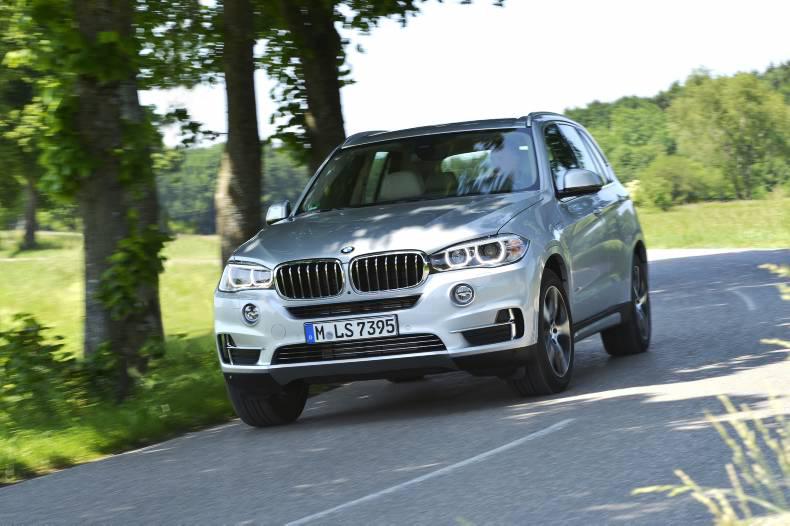The new BMW X5 xDrive40e and 330e are the first plug-in hybrid production cars from the BMW brand.
I had a short drive of the new XDrive models recently at a BMW drive event. The engine and hybrid combinations are impressive in terms of acceleration, power and smoothness. BMW has put the Toyota hybrid technology to good effect.
BMW claims that the new drive system combines the versatility and luxury of the X5, along with the superb traction provided by the BMW xDrive intelligent all-wheel-drive system and BMW’s EfficientDynamics eDrive technology for efficiency.
The interaction between the petrol engine and the electric drive together generate a total system output of 313bhp. This gives the new BMW X5 xDrive40e strong acceleration while delivering what BMW claims is a substantial reduction in fuel consumption and emissions.
BMW claims that this hybrid SUV returns a combined fuel consumption of up to 30km/litre (85.6mpg). The CO2 emissions are rated at just 77g/km.
The BMW X5 xDrive40e completes the 0 to 100km/h sprint in just 6.8 seconds and has top speed of 210km/h (electronically limited). In all-electric drive mode, the vehicle is capable of a top speed of 120km/h.
BMW claims that using a BMW i Wallbox charger it takes 2 hours and 45 minutes to fully recharge an empty battery pack. Hybrid X5 prices start at €72,020 (including VRT Relief).
BMW is also offering a similar hybrid drive for the new BMW 330e. The plug-in hybrid drive system pairs an electric motor producing 88bhp and a four-cylinder turbo petrol engine, which develops 184bhp and 290Nm. The car delivers and impressive acceleration of 0–100 km/h (62 mph) in just 6.1 seconds.
The electric motor and engine send their power to the BMW 330e’s rear wheels via a standard-fitted eight-speed Steptronic transmission. BMW claims that the arrangement of the electric motor in front of the transmission allows the transmission ratios to be used in all-electric mode as well. This means a torque converter can be omitted, which BMW claims partially cancels out the extra weight of the additional drive unit.
The new BMW X5 xDrive40e and 330e are the first plug-in hybrid production cars from the BMW brand.
I had a short drive of the new XDrive models recently at a BMW drive event. The engine and hybrid combinations are impressive in terms of acceleration, power and smoothness. BMW has put the Toyota hybrid technology to good effect.
BMW claims that the new drive system combines the versatility and luxury of the X5, along with the superb traction provided by the BMW xDrive intelligent all-wheel-drive system and BMW’s EfficientDynamics eDrive technology for efficiency.
The interaction between the petrol engine and the electric drive together generate a total system output of 313bhp. This gives the new BMW X5 xDrive40e strong acceleration while delivering what BMW claims is a substantial reduction in fuel consumption and emissions.
BMW claims that this hybrid SUV returns a combined fuel consumption of up to 30km/litre (85.6mpg). The CO2 emissions are rated at just 77g/km.
The BMW X5 xDrive40e completes the 0 to 100km/h sprint in just 6.8 seconds and has top speed of 210km/h (electronically limited). In all-electric drive mode, the vehicle is capable of a top speed of 120km/h.
BMW claims that using a BMW i Wallbox charger it takes 2 hours and 45 minutes to fully recharge an empty battery pack. Hybrid X5 prices start at €72,020 (including VRT Relief).
BMW is also offering a similar hybrid drive for the new BMW 330e. The plug-in hybrid drive system pairs an electric motor producing 88bhp and a four-cylinder turbo petrol engine, which develops 184bhp and 290Nm. The car delivers and impressive acceleration of 0–100 km/h (62 mph) in just 6.1 seconds.
The electric motor and engine send their power to the BMW 330e’s rear wheels via a standard-fitted eight-speed Steptronic transmission. BMW claims that the arrangement of the electric motor in front of the transmission allows the transmission ratios to be used in all-electric mode as well. This means a torque converter can be omitted, which BMW claims partially cancels out the extra weight of the additional drive unit.






 This is a subscriber-only article
This is a subscriber-only article






SHARING OPTIONS: